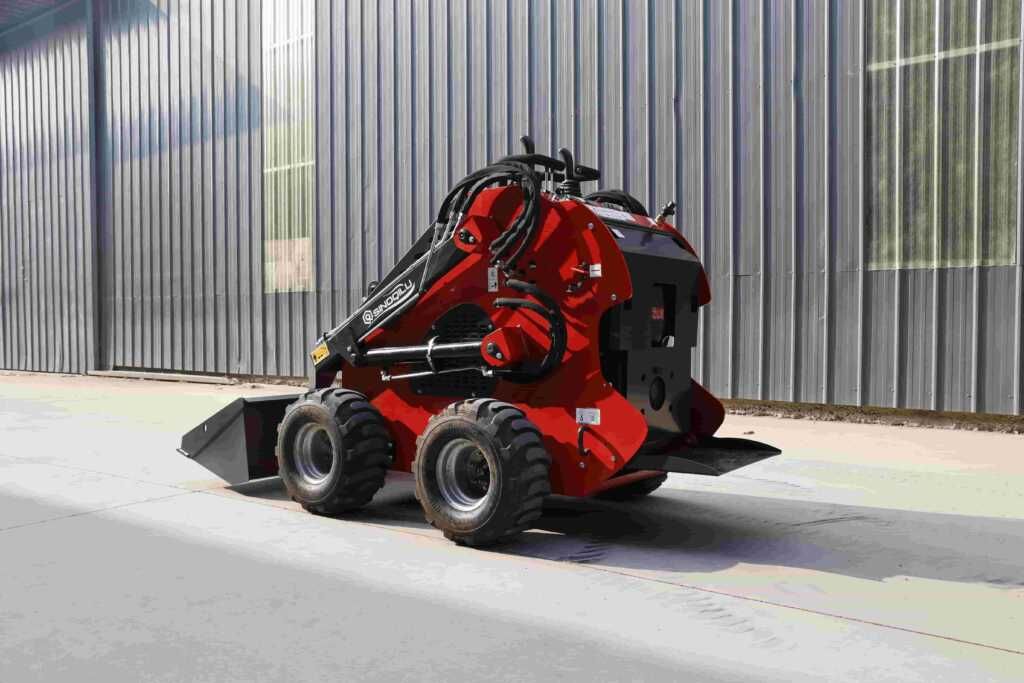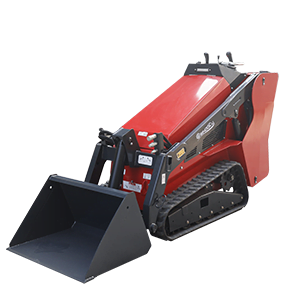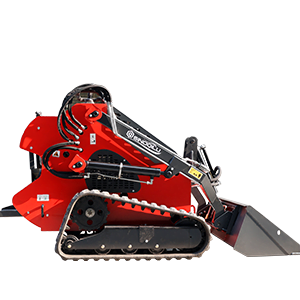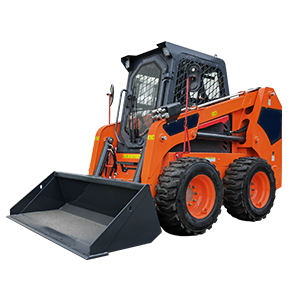E-mail: alamat email qilumachinery.com WhatsApp: 8618266768780
Cara Membeli Skid Steer Loader Terbaik: Panduan Lengkap
Perkenalan
Membeli skid steer loader merupakan investasi yang signifikan bagi bisnis apa pun yang bergerak di bidang konstruksi, lansekap, atau pertanian. Dengan beragamnya model dan fitur yang tersedia, membuat keputusan yang tepat sangatlah penting untuk memastikan Anda membeli skid steer loader terbaik untuk kebutuhan Anda. Panduan lengkap ini akan memandu Anda melalui faktor-faktor penting yang perlu dipertimbangkan, untuk memastikan Anda membuat pilihan yang tepat.
Memahami Mesin Pemuat Skid Steer

Sebelum menyelami secara spesifik tentang cara membeli skid steer loader terbaik, penting untuk memahami apa itu skid steer loader dan bagaimana fungsinya. Skid steer loader adalah peralatan serbaguna dan ringkas yang dilengkapi lengan angkat yang dapat dipasangi berbagai alat tambahan, menjadikannya aset penting dalam berbagai industri, termasuk konstruksi, lansekap, pertanian, dan banyak lagi. Mesin ini terkenal karena kemampuan manuvernya dan kemampuannya untuk beroperasi di ruang sempit, yang secara signifikan meningkatkan kegunaannya di berbagai lokasi kerja.
Struktur dan Fungsi Dasar
Skid steer loader dirancang dengan sistem kemudi yang unik. Tidak seperti kendaraan tradisional, skid steer loader menggunakan kemudi diferensial, yang berarti roda di setiap sisi loader dapat bergerak pada kecepatan dan arah yang berbeda. Hal ini memungkinkan mesin untuk melakukan putaran radius nol, membuatnya sangat lincah dan ideal untuk ruang terbatas di mana mesin lain mungkin kesulitan untuk beroperasi.
Lampiran dan Fleksibilitas
Salah satu fitur menonjol dari skid steer loader adalah kemampuannya untuk mengakomodasi berbagai macam attachment. Fleksibilitas ini mengubah loader dari mesin penggali sederhana menjadi mesin multifungsi yang mampu menangani berbagai tugas. Attachment yang umum termasuk bucket untuk menggali dan menyekop, auger untuk pengeboran, trencher untuk menggali parit sempit, garpu palet untuk memindahkan material, dan palu hidrolik untuk memecah beton. Kemampuan untuk beralih dengan cepat di antara attachment ini memungkinkan operator untuk menangani berbagai proyek dengan satu mesin.
Variasi Ukuran dan Daya
Skid steer loader tersedia dalam berbagai ukuran dan kapasitas daya untuk memenuhi berbagai kebutuhan operasional. Model yang lebih kecil ideal untuk proyek perumahan dan komersial skala kecil yang mengutamakan kemampuan manuver daripada tenaga semata. Di sisi lain, model yang lebih besar dibuat untuk menangani tugas berat di lokasi konstruksi besar, menyediakan daya dan kapasitas angkat yang diperlukan untuk memindahkan material dalam jumlah besar dengan cepat dan efisien.
Kapasitas Operasional dan Jenis Angkat
Saat membahas skid steer loader, dua jenis lift utama yang umum dirujuk: lift radial dan lift vertikal. Skid steer loader lift radial memiliki satu titik pivot pada lengan lift, sehingga ideal untuk pekerjaan di permukaan tanah seperti menggali dan meratakan tanah. Skid steer loader menawarkan jangkauan yang sangat baik pada ketinggian angkat tengah, yang bermanfaat untuk tugas-tugas seperti membuang material di atas tembok. Sebaliknya, skid steer loader lift vertikal memiliki titik pivot tambahan yang memungkinkan lengan lift bergerak lurus ke atas dan ke bawah. Desain ini memberikan stabilitas dan jangkauan yang lebih baik pada ketinggian angkat penuh, sehingga model lift vertikal lebih cocok untuk memuat material ke truk atau mengangkat palet.
Manfaat Utama
Ukuran yang ringkas dan kemampuan manuver skid steer loader membuatnya sangat diperlukan di lingkungan perkotaan dan ruang terbatas lainnya. Kemampuannya untuk berputar dalam jangkauannya sendiri memungkinkannya untuk menavigasi area yang tidak dapat dilalui oleh mesin yang lebih besar. Selain itu, konstruksinya yang kokoh dan mesin yang bertenaga memungkinkannya untuk menangani tugas-tugas yang menantang, mulai dari pengangkatan berat hingga perataan yang presisi. Fleksibilitas yang disediakan oleh attachment yang dapat dipertukarkan menjadikan skid steer loader sebagai investasi yang hemat biaya, karena satu mesin dapat melakukan beberapa fungsi di lokasi kerja.
Fitur Keamanan dan Kenyamanan
Skid steer loader modern dirancang dengan mengutamakan keselamatan dan kenyamanan operator. Kabin tertutup dengan sistem kontrol iklim melindungi operator dari cuaca dan mengurangi kelelahan selama jam kerja yang panjang. Fitur keselamatan canggih, seperti struktur pelindung terguling (ROPS) dan struktur pelindung benda jatuh (FOPS), memastikan bahwa operator terlindungi dari potensi bahaya. Selain itu, visibilitas yang lebih baik dari kabin dan kontrol ergonomis berkontribusi pada pengoperasian yang lebih efisien dan aman.
Mengevaluasi Kebutuhan Anda
Untuk membeli skid steer loader terbaik, Anda harus mengevaluasi secara menyeluruh kebutuhan spesifik Anda dan bagaimana mesin tersebut akan digunakan. Ini melibatkan analisis komprehensif dari berbagai faktor untuk memastikan bahwa skid steer loader yang dipilih akan memenuhi tuntutan operasional Anda dan memberikan kinerja yang optimal. Berikut adalah beberapa pertimbangan utama untuk membantu Anda menilai kebutuhan Anda secara efektif:
Menilai Sifat Pekerjaan Anda
Pertama dan terutama, pertimbangkan jenis pekerjaan yang akan Anda lakukan dengan skid steer loader. Tugas yang berbeda mungkin memerlukan spesifikasi dan attachment yang berbeda. Misalnya, jika aktivitas utama Anda melibatkan pengangkatan berat dan penanganan material, Anda akan memerlukan loader dengan kapasitas operasi yang tinggi dan lengan pengangkat yang kuat. Di sisi lain, jika Anda terlibat dalam tugas-tugas seperti perataan tanah, penggalian, atau penataan lanskap, Anda mungkin memprioritaskan fitur-fitur seperti kontrol presisi, kemampuan manuver, dan ketersediaan attachment tertentu seperti bucket atau trencher.
Lingkungan Tempat Kerja
Karakteristik fisik tempat kerja Anda berperan penting dalam menentukan skid steer loader yang tepat. Pertimbangkan faktor-faktor berikut:
- Batasan Ruang: Jika Anda akan bekerja di tempat yang sempit atau terbatas, skid steer loader yang ringkas dengan kemampuan manuver yang sangat baik dan radius putar yang kecil sangatlah penting. Sebaliknya, lokasi yang lebih luas dan terbuka dapat diuntungkan dengan model yang lebih besar dan lebih bertenaga.
- Medan: Jenis medan yang akan Anda lalui merupakan faktor penting lainnya. Untuk medan yang kasar, tidak rata, atau berlumpur, skid steer loader dengan ground clearance yang tinggi dan ban atau track yang kuat akan memberikan stabilitas dan traksi yang lebih baik.
- Aksesibilitas: Evaluasi seberapa mudah alat angkut dapat diangkut ke dan dari lokasi kerja. Jika pemindahan sering diperlukan, pertimbangkan ukuran dan berat alat angkut dalam kaitannya dengan peralatan angkut Anda.
Frekuensi dan Durasi Penggunaan
Seberapa sering dan berapa lama Anda akan menggunakan skid steer loader memengaruhi jenis mesin yang harus Anda beli. Untuk penggunaan sesekali, model kelas menengah mungkin cukup, menawarkan keseimbangan antara biaya dan kemampuan. Namun, untuk operasi harian yang intensif, berinvestasi dalam model berkinerja tinggi dengan komponen yang tahan lama dan mesin yang andal sangat penting untuk meminimalkan waktu henti dan biaya perawatan.
Fitur dan Lampiran Spesifik
Identifikasi fitur dan perlengkapan khusus yang akan meningkatkan produktivitas dan efisiensi Anda. Fitur umum yang perlu dipertimbangkan meliputi:
- Aliran Hidrolik: Hidraulik aliran tinggi diperlukan untuk mengoperasikan attachment yang menuntut seperti auger dan palu hidrolik. Pastikan loader yang Anda pilih memiliki kapasitas hidrolik yang cukup untuk attachment yang akan Anda gunakan.
- Desain Kabin: Kabin yang nyaman dan dirancang secara ergonomis dapat berdampak signifikan pada efisiensi dan keselamatan operator. Carilah fitur-fitur seperti kursi yang dapat disesuaikan, visibilitas yang jelas, kontrol yang intuitif, dan sistem kontrol iklim.
- Jalur Angkat: Tentukan apakah jalur angkat radial atau vertikal lebih cocok untuk tugas Anda. Loader angkat radial biasanya lebih baik untuk pekerjaan di permukaan tanah, sedangkan model angkat vertikal lebih menguntungkan untuk pemuatan dan penanganan material di ketinggian yang lebih tinggi.
Anggaran dan Total Biaya Kepemilikan
Meskipun harga pembelian awal merupakan pertimbangan utama, sama pentingnya untuk mengevaluasi total biaya kepemilikan selama masa pakai alat berat. Ini termasuk biaya berkelanjutan seperti bahan bakar, perawatan, perbaikan, asuransi, dan potensi waktu henti. Buat anggaran terperinci yang memperhitungkan faktor-faktor ini untuk memastikan bahwa skid steer loader yang Anda pilih layak secara finansial dalam jangka panjang.
Mempersiapkan Investasi Anda untuk Masa Depan
Pertimbangkan kebutuhan bisnis Anda di masa mendatang dan apakah skid steer loader yang Anda beli dapat mengakomodasi potensi pertumbuhan atau perubahan dalam operasi Anda. Berinvestasi dalam mesin serbaguna dengan kemampuan untuk menangani berbagai tugas dan perlengkapan dapat memberikan nilai dan kemampuan beradaptasi yang lebih besar seiring dengan perkembangan bisnis Anda.
Konsultasi dengan Ahli dan Operator
Terakhir, konsultasikan dengan pakar industri, operator, dan kolega yang memiliki pengalaman dengan skid steer loader. Wawasan dan rekomendasi mereka dapat memberikan perspektif berharga tentang model dan fitur yang paling sesuai untuk kebutuhan spesifik Anda. Selain itu, banyak dealer menawarkan demonstrasi atau uji coba, yang memungkinkan Anda merasakan kinerja alat berat secara langsung sebelum membuat keputusan akhir.
Tabel: Mengevaluasi Kebutuhan Anda
| Faktor | Pertimbangan | Contoh |
|---|---|---|
| Sifat Pekerjaan | Jenis tugas yang akan dilakukan loader | Pengangkatan berat, penanganan material, perataan, penggalian |
| Lingkungan Tempat Kerja | Keterbatasan ruang, jenis medan, dan aksesibilitas | Ruang sempit, medan kasar, transportasi mudah |
| Frekuensi dan Durasi Penggunaan | Seberapa sering dan berapa lama loader akan digunakan | Penggunaan sesekali, operasi sehari-hari |
| Fitur dan Lampiran Spesifik | Fitur yang diperlukan dan kompatibilitas dengan lampiran | Hidraulik aliran tinggi, kenyamanan kabin, jalur pengangkatan |
| Anggaran dan Total Biaya Kepemilikan | Biaya awal, biaya berkelanjutan (bahan bakar, pemeliharaan, asuransi), dan penyusutan | Pembelian $5.000 – $25.000, pemeliharaan $1.000 – $5.000 |
| Investasi yang Siap Menghadapi Masa Depan | Kemampuan untuk menangani pertumbuhan masa depan dan perubahan kebutuhan operasional | Fleksibel, kompatibel dengan berbagai attachment |
| Konsultan Ahli dan Operator | Wawasan dari para ahli industri, operator, dan kolega | Rekomendasi, pengalaman langsung |
Pertimbangan Merek dan Dealer
Memilih merek dan dealer yang memiliki reputasi baik sangat penting saat Anda membeli skid steer loader terbaik. Merek terkenal seperti Bobcat, Caterpillar, dan John Deere menawarkan mesin yang andal dan layanan pelanggan yang sangat baik. Saat memilih dealer, cari dealer yang memiliki reputasi baik dalam hal layanan dan dukungan, serta lokasi yang strategis untuk suku cadang dan perawatan.
Pemeliharaan dan Dukungan
Memiliki skid steer loader memerlukan perawatan rutin untuk memastikan kinerja dan keawetan yang optimal. Saat membeli, pertimbangkan ketersediaan suku cadang, kemudahan perawatan, dan dukungan yang diberikan oleh dealer. Garansi yang baik juga dapat memberikan ketenangan pikiran.
Pembiayaan dan Penganggaran
Membeli skid steer loader terbaik memerlukan investasi finansial yang signifikan, dan sangat penting untuk merencanakan pembiayaan dan penganggaran Anda dengan cermat guna memastikan Anda melakukan pembelian yang berkelanjutan dan hemat biaya. Memahami implikasi finansial secara menyeluruh dan menjajaki berbagai opsi pembiayaan akan membantu Anda membuat keputusan yang tepat. Berikut ini beberapa pertimbangan terperinci untuk memandu Anda melalui proses pembiayaan dan penganggaran:
Harga Pembelian Awal
Harga pembelian awal skid steer loader dapat sangat bervariasi, tergantung pada model, merek, dan fiturnya. Penting untuk menetapkan anggaran yang realistis yang sesuai dengan kemampuan finansial Anda sekaligus mempertimbangkan kualitas dan kemampuan mesin. Pilihan yang lebih murah mungkin menghemat uang di awal, tetapi dapat mengakibatkan biaya perawatan dan pengoperasian yang lebih tinggi seiring berjalannya waktu.
Opsi Pembiayaan
Ada beberapa opsi pembiayaan yang tersedia untuk membantu mengelola biaya pembelian skid steer loader. Setiap opsi memiliki kelebihan dan pertimbangannya sendiri:
Pembelian Langsung
Membayar penuh di muka adalah pilihan yang paling mudah dan menghilangkan kewajiban pembiayaan di masa mendatang. Pendekatan ini dapat bermanfaat jika Anda memiliki cukup modal dan ingin menghindari pembayaran bunga. Namun, pendekatan ini juga mengikat sejumlah besar uang tunai yang dapat digunakan untuk operasi bisnis lainnya.
Pinjaman Peralatan
Pinjaman peralatan merupakan cara umum untuk membiayai pembelian skid steer loader. Pinjaman ini biasanya menawarkan suku bunga tetap dan jangka waktu pembayaran mulai dari beberapa tahun hingga satu dekade. Manfaat utama pinjaman peralatan meliputi:
- Pelestarian Modal Kerja: Dengan menyebarkan biaya dari waktu ke waktu, Anda dapat mempertahankan likuiditas untuk kebutuhan bisnis lainnya.
- Manfaat Pajak:Pembayaran bunga atas pinjaman peralatan sering kali dapat dikurangkan dari pajak.
Penyewaan
Leasing merupakan opsi yang menarik bagi bisnis yang ingin menghindari biaya awal yang besar terkait dengan pembelian. Perjanjian sewa dapat disusun dengan berbagai cara, seperti:
- Sewa Operasional: Mirip dengan menyewa, dengan pembayaran bulanan yang lebih rendah dan opsi untuk meningkatkan ke model yang lebih baru di akhir jangka waktu sewa.
- Sewa Modal: Lebih seperti pembelian, di mana Anda memiliki peralatan di akhir jangka waktu sewa.
Sewa menawarkan fleksibilitas, tetapi total biaya dari waktu ke waktu mungkin lebih tinggi daripada membeli langsung.
Sewa untuk Dimiliki
Perjanjian sewa beli memungkinkan Anda menyewa skid steer loader dengan opsi untuk membelinya di akhir masa sewa. Ini bisa menjadi cara yang baik untuk menguji peralatan sebelum melakukan pembelian penuh. Sebagian dari pembayaran sewa biasanya digunakan untuk harga pembelian, sehingga memudahkan transisi dari sewa ke kepemilikan.
Total Biaya Kepemilikan
Saat membuat anggaran untuk skid steer loader, penting untuk mempertimbangkan total biaya kepemilikan (TCO) di luar harga pembelian awal. TCO mencakup semua biaya yang terkait dengan pengoperasian dan perawatan mesin selama masa pakainya. Komponen utama TCO adalah:
Perawatan dan Perbaikan
Perawatan rutin sangat penting untuk menjaga skid steer loader dalam kondisi optimal. Anggaran untuk layanan rutin seperti penggantian oli, penggantian filter, dan inspeksi. Selain itu, pertimbangkan biaya perbaikan potensial untuk keausan atau kerusakan yang tidak terduga.
Biaya Bahan Bakar
Bahan bakar merupakan biaya berkelanjutan yang signifikan untuk mengoperasikan skid steer loader. Perkirakan penggunaan bahan bakar Anda berdasarkan efisiensi bahan bakar alat berat dan jumlah jam pengoperasiannya. Harga bahan bakar yang berfluktuasi juga harus diperhitungkan dalam anggaran Anda.
Asuransi
Mengasuransikan skid steer loader Anda akan melindungi Anda dari potensi kerugian akibat kecelakaan, pencurian, atau kerusakan. Biaya asuransi akan bervariasi berdasarkan faktor-faktor seperti nilai mesin, lokasi Anda, dan tingkat pertanggungan.
Penyusutan
Penyusutan merupakan kerugian nilai skid steer loader dari waktu ke waktu. Meskipun merupakan biaya non-tunai, memahami penyusutan membantu dalam menilai nilai jual kembali alat berat dan merencanakan peningkatan peralatan di masa mendatang.
Pelatihan Operator dan Biaya Tenaga Kerja
Berinvestasi dalam pelatihan operator dapat meningkatkan efisiensi dan keselamatan, mengurangi kemungkinan kecelakaan dan penyalahgunaan peralatan. Selain itu, pertimbangkan biaya tenaga kerja yang terkait dengan perekrutan operator terampil.
Perencanaan Keuangan dan ROI
Membuat rencana keuangan terperinci yang mencakup semua pengeluaran ini akan membantu Anda memahami keseluruhan investasi yang dibutuhkan dan potensi laba atas investasi (ROI). Hitung ROI dengan membandingkan biaya skid steer loader dengan pendapatan atau penghematan yang dihasilkannya untuk bisnis Anda. Analisis ini akan membantu Anda menentukan apakah investasi tersebut bermanfaat dan berapa lama waktu yang dibutuhkan untuk menutup biaya tersebut.
Mencari Saran Profesional
Jika Anda tidak yakin tentang opsi pembiayaan terbaik atau memerlukan bantuan dalam penganggaran, pertimbangkan untuk berkonsultasi dengan penasihat keuangan atau spesialis pembiayaan peralatan. Mereka dapat memberikan wawasan berharga dan solusi yang disesuaikan berdasarkan kesehatan dan tujuan keuangan bisnis Anda.
Uji Coba dan Demonstrasi

Sebelum menyelesaikan pembelian Anda, mengatur uji coba atau demonstrasi skid steer loader merupakan langkah penting. Pengalaman langsung ini akan memberikan wawasan yang sangat berharga mengenai kinerja, kenyamanan, dan kemudahan penggunaan alat berat, yang memastikan bahwa Anda membeli skid steer loader terbaik untuk kebutuhan Anda. Berikut adalah beberapa pertimbangan dan langkah terperinci yang harus diikuti saat menjadwalkan uji coba dan demonstrasi:
Pentingnya Test Drive
Uji coba memungkinkan Anda menilai langsung kemampuan skid steer loader dalam kondisi nyata. Evaluasi praktis ini membantu Anda menentukan apakah alat berat tersebut memenuhi persyaratan operasional dan memberikan kinerja yang diperlukan untuk tugas Anda. Uji coba dapat mengungkap potensi masalah atau keterbatasan yang mungkin tidak terlihat dari spesifikasi atau brosur saja.
Penjadwalan Uji Coba Kendaraan
Untuk mengatur uji coba, hubungi dealer atau perwakilan produsen setempat. Sebagian besar dealer yang memiliki reputasi baik akan dengan senang hati mengatur demonstrasi di fasilitas mereka atau di lokasi kerja Anda. Berikut ini beberapa kiat untuk menjadwalkan uji coba:
- Rencanakan Kedepan: Hubungi dealer jauh-jauh hari untuk menjadwalkan waktu yang tepat untuk uji coba. Ini memastikan bahwa mesin yang Anda minati tersedia dan Anda memiliki cukup waktu untuk mengevaluasinya secara menyeluruh.
- Siapkan Daftar Periksa: Buat daftar periksa berisi fitur dan fungsi tertentu yang ingin Anda uji. Ini dapat mencakup kapasitas angkat, kemampuan manuver, kompatibilitas attachment, dan kenyamanan kabin. Memiliki daftar periksa memastikan Anda mencakup semua aspek penting selama uji berkendara.
- Bawa Tim Anda: Libatkan anggota tim utama, seperti operator dan personel pemeliharaan, dalam uji coba. Pengalaman langsung dan masukan mereka dapat memberikan perspektif berharga tentang kesesuaian alat berat untuk operasi Anda.
Melakukan Test Drive
Selama uji coba berkendara, perhatikan dengan saksama aspek-aspek berikut untuk memastikan skid steer loader memenuhi harapan Anda:
Performa dan Penanganan
- Tenaga Mesin: Uji loader di bawah berbagai beban untuk menilai daya mesin dan responsnya. Pastikan loader dapat menahan beban maksimum yang Anda perkirakan akan diangkat.
- Kemampuan manuver: Mengevaluasi kemampuan mesin untuk melewati ruang sempit dan berbelok tajam. Mengujinya dalam kondisi yang menyerupai lingkungan kerja Anda yang biasa.
- Sistem Hidrolik: Periksa kinerja sistem hidrolik, terutama jika Anda berencana menggunakan attachment aliran tinggi. Pastikan pengoperasian lengan pengangkat dan fungsi hidrolik lainnya berjalan lancar dan efisien.
Kenyamanan dan Ergonomi
- Desain Kabin: Duduklah di kursi operator dan nilai kenyamanan, visibilitas, dan ergonomi kabin. Cari kursi yang dapat disesuaikan, kontrol yang intuitif, dan visibilitas yang cukup untuk memastikan lingkungan kerja yang aman dan efisien.
- Kebisingan dan Getaran: Perhatikan tingkat kebisingan dan getaran di dalam kabin. Kebisingan atau getaran yang berlebihan dapat menyebabkan kelelahan dan ketidaknyamanan operator dalam jangka waktu lama.
Kemudahan Pengoperasian
- Kontrol: Uji responsivitas dan kemudahan penggunaan kontrol mesin. Pastikan kontrol tersebut intuitif dan memberikan penanganan yang tepat.
- Perubahan Lampiran: Jika memungkinkan, cobalah mengganti attachment untuk mengevaluasi kemudahan dan kecepatan proses ini. Penggantian attachment yang cepat dan mudah dapat meningkatkan produktivitas secara signifikan.
Fitur Keamanan
- Sistem Keamanan: Periksa fitur keselamatan penting seperti struktur pelindung terguling (ROPS), struktur pelindung benda jatuh (FOPS), dan mekanisme penghentian darurat. Pastikan fitur-fitur ini memenuhi standar industri dan persyaratan keselamatan khusus Anda.
Evaluasi Pasca Uji Coba
Setelah uji coba, kumpulkan umpan balik dari semua peserta dan bandingkan catatan. Diskusikan kinerja mesin, kenyamanan, dan masalah apa pun yang ditemukan. Pertimbangkan pertanyaan berikut:
- Apakah skid steer loader memenuhi harapan kinerja Anda?
- Apakah kontrol dan pengoperasiannya intuitif dan nyaman?
- Apakah mesin tersebut menangani semua tugas dan lampirannya secara efektif?
- Apakah ada masalah keselamatan atau ergonomis?
Membuat Keputusan yang Tepat
Gunakan wawasan yang diperoleh dari uji coba untuk membuat keputusan yang tepat. Bandingkan kinerja berbagai model jika Anda menguji lebih dari satu, dan pertimbangkan kelebihan dan kekurangan masing-masing. Pertimbangkan seberapa baik setiap mesin sesuai dengan kebutuhan operasional dan anggaran Anda.
Tindak Lanjut dengan Dealer
Setelah uji coba, hubungi dealer untuk membahas pertanyaan atau masalah yang muncul selama demonstrasi. Dealer yang memiliki reputasi baik akan bersedia mengatasi masalah apa pun dan mungkin menawarkan dukungan tambahan atau opsi penyesuaian untuk memenuhi kebutuhan Anda.
Kesimpulan:Beli Skid Steer Loader Terbaik
Membeli skid steer loader terbaik memerlukan pertimbangan cermat terhadap kebutuhan spesifik Anda, fitur alat berat, dan dukungan yang diberikan oleh dealer. Dengan mengikuti panduan lengkap ini, Anda dapat membuat keputusan yang tepat yang akan meningkatkan produktivitas dan efisiensi Anda di lokasi kerja.
Tanya Jawab Umum
Apa fitur terpenting yang perlu dipertimbangkan saat membeli? pemuat kemudi selip?
Fitur yang paling penting bergantung pada kebutuhan spesifik Anda, tetapi daya mesin dan kapasitas pengoperasian sangat krusial untuk kinerja dan produktivitas.
Bisakah saya menggunakan skid steer loader untuk berbagai jenis tugas?
Ya, skid steer loader serba guna dan dapat digunakan untuk berbagai tugas dengan perlengkapan yang tepat.
Seberapa sering saya harus melakukan perawatan pada ponsel saya? pemuat kemudi selip?
Perawatan rutin harus dilakukan sesuai anjuran produsen, biasanya setelah setiap 250 jam pengoperasian.
Apakah lebih baik membeli atau menyewa skid steer loader?
Keputusan untuk membeli atau menyewa bergantung pada situasi keuangan Anda dan seberapa sering Anda akan menggunakan mesin tersebut. Menyewa dapat menjadi pilihan yang baik untuk kebutuhan jangka pendek atau musiman.
Bagaimana cara memilih lampiran yang tepat untuk saya? pemuat kemudi selip?
Pertimbangkan jenis tugas yang perlu Anda lakukan dan pilih attachment yang kompatibel dengan skid steer loader Anda dan cocok untuk tugas tersebut.
Tentang Kami
Shandong Qilu Industrial Co., Ltd. adalah produsen dan eksportir profesional yang mengintegrasikan pengembangan dan produksi ekskavator, loader, dan traktor. Kami memberikan layanan terbaik, tentu saja.
Tulisan Terbaru
Video demo
-1.png)
Hubungi Kami Hari Ini!
Ada pertanyaan, penawaran, atau permintaan? Klik tombol untuk mengirim pesan.
Qilu Industrial akan selalu siap membantu.



